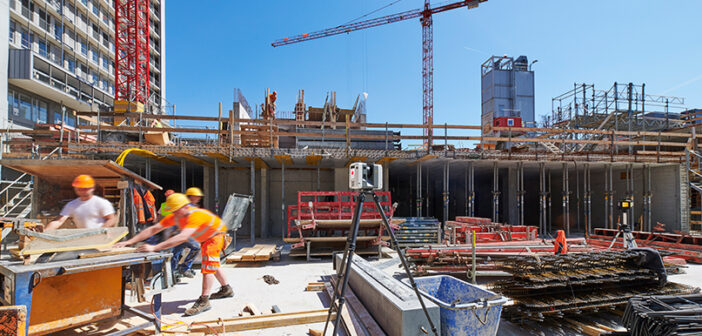Addressing the biggest myths we’ve heard about sustainable building practices and reality capture technology
We’ve all heard plenty of myths in the building construction industry, from “construction is only for men” to “it’s not safe to work in construction”. But in recent years, Hexagon has been addressing bigger stories in the industry – stories that relate to the future of our planet.
As society has increased its technological and industrial prowess, so has the damage to our planet. Building construction has played a part in this damage. It’s well documented that buildings consume resources, and worldwide statistics show that buildings are responsible for around 40% of energy and process-related CO2 emissions, 50% of all extracted materials, 33% of water consumption and 35% of generated waste. These statistics are shocking and must inspire change towards greener methods.
Green construction is a newer term being used in the industry that refers to better management of these unsustainable processes. It represents a fundamental shift in the way we think about buildings and their role in shaping our world, including building processes that are not only sustainable but regenerative – actively contributing to the health of the planet and its inhabitants. It represents a future where buildings are not just energy-efficient but net-zero or even energy-positive, producing more energy than they consume. It’s a call to action for architects, builders and policymakers to embrace a holistic approach to building design and construction – one that recognises the importance of building in harmony with nature.
While undoing the damage of years of negligence and poor practice in the building construction industry won’t happen overnight, sustainability awareness is growing, which has sparked new myths within the industry. These myths increasingly relate to green construction and sustainable building practices in the last year.
In this blog, we bust some common myths and share the facts about sustainable building and address how the construction industry can use digital twins to create prefabricated elements in building construction, can recycle materials to reduce waste, encompass best practices and innovative technology and most importantly, the facts.
 Green construction methods cost more money
Green construction methods cost more money
False. The notion that green construction is an expensive and impractical approach to building is outdated and incorrect. In fact, green construction practices are rapidly becoming more cost-effective and accessible than traditional building methods.
Building with a modular construction process and owning a digital twin of your building, the entire project can benefit from less material waste and energy consumption. This will save budget on unnecessary materials and the cost of energy, as well as produce higher build quality that will minimise repairs in the future. For example, in Japan, Prex recognised the need to develop more accessible and sustainable housing to help people experience an increased standard of living. To address both these issues, Prex developed and now deploys precast foundations, which can be constructed in a shorter period of time with fewer workers at a lower cost.
We can create more energy-efficient and environmentally friendly buildings by embracing green construction. Furthermore, by implementing green construction techniques, we contribute to creating a more sustainable future for future generations. With innovation and advancements in green technology, we have the power to transform the construction industry and build a more sustainable world for all.
 Green construction is just a trend
Green construction is just a trend
False. What is critical to understand is that technological capabilities are permeating every industry, so digital advancements can’t be avoided in construction. Why would they? They will become a necessity for the future of work, societies, and our planet. Green construction is one of the most fundamental changes we need to make for our planet, and digital twins support this change. Green buildings have been growing in popularity and importance for several decades and are here to stay as a way to address environmental concerns and promote sustainability.
Green construction provides a vision of a future where buildings are not just structures but living systems that are intricately connected to their surroundings. You may have heard of the Metaverse or Hexagon’s Smart Digital Reality™, which are underpinned by reality capture technology. The Metaverse, for example, promises to be a game-changer for architects, engineers and builders, enabling them to create, test and refine sustainable designs and processes before work starts on site, to reduce waste during the building phase and then throughout the lifetime of the building to reduce the impact on the environment in which they stand. By leveraging the power of real-time data and analytics, Smart Digital Realities are set to simulate the impact of various materials, technologies and building systems, giving designers first-hand knowledge of the most sustainable and efficient solutions. Moreover, with the ability to create, store, and share data in the Metaverse, architects, engineers and builders can easily collaborate, breaking down traditional silos and accelerating innovation. Such widespread change is set to shape our future – not just for the benefit of the planet but for construction firms to stand out from the crowd and attract employees looking to make a difference.
 Green construction won’t make much of an impact
Green construction won’t make much of an impact
False. Think about every phase of the workflow when it comes to building. By having a digital twin in play from design to construction and then the operation of a building, it’s possible to minimise not only material waste by prefabricating components and making them off-site in a controlled environment but also to reduce the amount of rework on the project through real-time insights of the project within its digital twin. Fewer lorries will visit the building site, which saves on damaging emissions through transport. In the future, if a building needs to move or the site is redeveloped, this can be achieved more easily to the larger building components used in construction, saving on demolition costs. Also, building materials themselves are becoming more sustainable, often constructed using recycled or renewable materials, which helps reduce waste and conserve natural resources.
As the world grapples with the challenges of climate change, the circular economy approach is also becoming a focus for construction. The circular economy is based on ‘make, use and reuse’ principles instead of ‘make, use, dispose of’, encouraging operations to maximise resources while minimising waste and reducing emissions such as carbon dioxide. Currently, only 40% of construction waste is recycled or reused, with most not being used to create new buildings. This is where reality capture technology can make an impact. Surveyors and architects can create digital twins of existing buildings, identifying and documenting assets that can be sustainably reused and recycled.

Using reality capture technology to create a digital twin of a building, energy efficiency can be monitored in real-time, leading to significant cost savings and reduced energy bills over time, with buildings requiring less energy to operate than traditional structures. What’s more, green buildings are designed to breathe. They improve indoor air quality and promote healthy and harmonious indoor environments that support human health and well-being. This can range from advanced ventilation systems that introduce fresh air while removing pollutants and allergens or incorporating cutting-edge technologies and natural design strategies to optimise airflow and enhance indoor air quality. Green buildings are at the forefront of innovation, from living walls and green roofs that purify the air to smart sensors and AI-powered systems that monitor and adjust air flow in real-time. They are redefining what it means to breathe clean air indoors.
Preserving our future
Sustainable building also fosters a deeper appreciation for the history and heritage of existing buildings. Surveyors and architects can use reality capture technology to identify and address maintenance in historic structures so they can co-exist alongside new buildings. By preserving or repurposing historical structures, the construction industry can contribute to preserving of our cultural heritage – all while creating new opportunities for economic growth and social development.
It’s no secret that the world is leaning towards more sustainable alternatives in general, and this can also be said for green buildings and construction. This increased market demand will drive innovation and investment in this area. For the future of our planet, it’s no longer optional.
Click here to learn more about Hexagon’s Sustainability strategy and download the Sustainability Report.
Overcoming the data leverage gap: Unlock the potential of your construction projects by closing the gap between data captured and date leveraged! Autonomous technology, such as sensor-software solutions, collects, analyses and distributes data more effectively — leading to better project outcomes.















